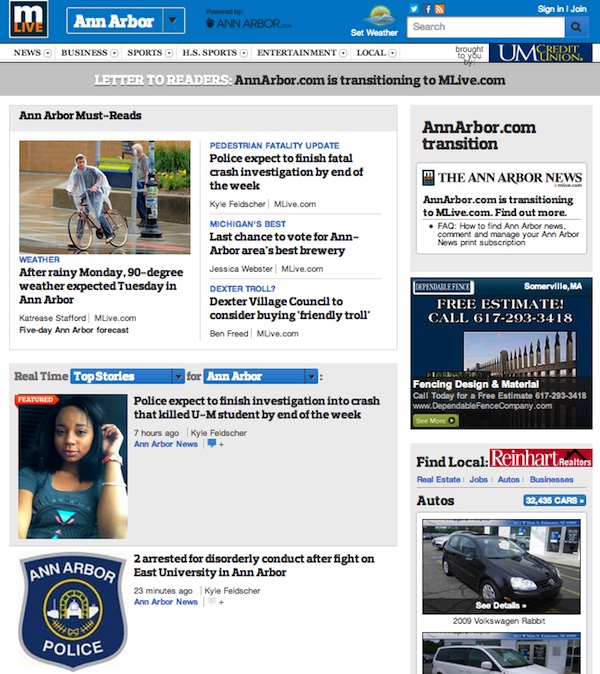
Back in 2009, the news-about-news world was focused on Ann Arbor — and not because Michigan football was any good. That was when The Ann Arbor News, published in some form since 1835, was shut down and replaced with AnnArbor.com — which was a website, but also the name of a twice-weekly print edition.
Earlier that year, the Seattle Post-Intelligencer and Rocky Mountain News had both given up the ghost — but at least those were two-newspaper cities being reduced to a single daily. Other than the student newspaper at the University of Michigan, Ann Arbor had no other daily newspaper to fall back on.
While the publication was roundly mocked for printing a newspaper with a “.com” suffix right there in the masthead, the new website did some interesting things and affirmed the promise of the remaining staff — those not among the dozens laid off — to commit fully to a digital operation.
Last week, four years later, a new new reality was announced. First, the AnnArbor.com print edition will once again be known as The Ann Arbor News, and see slightly reorganized and expanded coverage, with the same printing schedule. Secondly, AnnArbor.com itself will be abandoned; all content produced by the AnnArbor.com newsroom will live on the MLive.com Ann Arbor page, MLive.com being the shared website of all Advance Newspapers’ propertied in Michigan. AnnArbor.com will continue to live on as an archive.
You can think of this as the latest iteration of Advance’s multi-state, multi-year efforts to manage a move away from seven-day print publication. Ann Arbor and its fellow Michigan papers were the first tests before its better known moves in New Orleans and, more recently, in Cleveland and Portland. In each of those cases, Advance promoted a parallel digital brand — NOLA.com in New Orleans, for instance — while scaling back print. What was different in Ann Arbor was abandoning the print brand entirely. Now that’s reversing.
It’s as much an organizational issue as anything else. According to an email from Laurel Champion, general manager of southeast Michigan for MLive, nobody is going to lose their job and none of the content is going to change. AnnArbor.com had just been able to avoid the larger consolidation of Advance’s Michigan properties under MLive.com in 2011. About a year ago, some of AnnArbor.com’s sports coverage was moved to MLive; as of this Thursday, the rest moves, too.
In the announcement, MLive president Dan Gaydou says the reasons for the rebranding are simplicity and efficiency: “Integrating Ann Arbor with its other media properties across the state enables MLive Media Group to leverage our unified strengths, ultimately offering readers a better news experience, both online and in print.” That means it’ll use the responsive-friendly (though oft criticized) MLive layout, which echoes the look of the rest of Advance’s websites. And it’ll be one fewer CMS and backend for Advance to manage.
But there remains a natural fear that increased efficiency is the natural predecessor to layoffs. Even if the AnnArbor.com staff remains intact, there are statewide reporters who share at least part of those beats. In response to these concerns, Champion writes via email:
All MLive Media Group local markets have made a point of aligning their coverage to their local communities and topics, with a statewide team coordinating stories that either fall outside those markets or touch on all of them to eliminate redundancies and further focus our efforts on the core local coverage that defines us and that our readers come to us for.
One of the goals AnnArbor.com set for itself back in 2009 was to build an engaged audience. While the print circulation is down to around 30,000 from 45,000 in 2009, it only takes a quick read of the comments section to know that AnnArbor.com online readers are a fierce bunch. (The only digital figures Advance provided pertained to MLive.com’s readership and popularity as a news source; none spoke to AnnArbor.com independently.)
The AnnArbor.com staff takes their commenters very seriously, typically addressing comments individually. As John Kroll, until recently of The Cleveland Plain Dealer, points out, community moderator Jen Eyer has gone so far as to pen multiple posts — “4 signs you might be trolling Wolverines and Spartans stories” — offering guidelines to to frustrated users who don’t understand why their comments keep “disappearing” and help to confused users who need assistance navigating the layout.
The result is a commentariat that expects to be listened to and engaged with honestly — not in what one commenter referred to as “MBA-speak.” Chief among their concerns: how comments would be moderated, the perceived poor quality of the MLive.com layout, the potential for reduced coverage, and most of all, that business concerns were being given primacy over the journalistic needs of the community.
MLive’s Champion says readers should be easily able to adapt to the new site, which draws on the river-of-news look of the original AnnArbor.com design, as well as in the way feature stories are displayed.

But, while Champion says user engagement is highly valued at MLive, a lot of those users are concerned that their the value of their preferred local news source will decrease as it becomes homogenized within the MLive system. Consider this reader’s loyalty to the character of the paper:
Lets not be too snide in our remarks, there was genuine intent and genuine effort in the running of Ann Arbor dot com. I miss the late night emails and even phone calls from (now long gone) Tony Dearing and Stephanie Murray. These two, in particular, took their careers as journalists very seriously. And they appreciated that an ordinary citizen like myself took such a strong interest in seeing that Ann Arbor had a first-rate news outlet.
As in many periods of great change, some have already promised to turn to local competitors once the move is complete. Neither the Ann Arbor Observer and the Ann Arbor Chronicle will shy away from taking opportunities that are open to them. Dave Askins of the Chronicle said in an email he doubts that cost savings are the primary motivator in the change: “It’s just that AnnArbor.Com is a magnificently dumb name to print on a masthead and to deliver to people’s doorsteps. And it took four years for that basic insight finally to sink in.” Meanwhile, here’s John Hilton of the Ann Arbor Observer:
We do see an advertising opportunity in the incredibly low print circulation numbers released as part of the announcement: they now print fewer issues in an entire week than the old Ann Arbor News printed in a single day. That confirms what our ad staff has been telling us — that new advertisers are coming to the Observer because they’re not getting the response they want from annarbor.com. Changing the name may bring back memories of the old paper, but it won’t address their core problem — they’ve cut their circulation so much that it’s just a ghost of its former self.
But of course, the reinvention of the first Ann Arbor News as AnnArbor.com was not a play in the circulation game — it was mean to strengthen the digital space and reduce the operation’s reliance on print revenue, whose general downward trend has been obvious for a long time. The AnnArbor.com staff has shown they’re good at building the loyalty of digital audiences across brands. Even as commenters complain, insult, threaten to leave, voice their lamentations in verse and even demand subscription refunds, the staff remains, rolling with the punches and participating in the dialogue.
For example, here’s John Hiner, VP of content, in the comments:
Thanks for reading, and thanks for your comments. The statewide MLive homepage has not a strong Ann Arbor presence in the past several years because of the existence of AnnArbor.com, which is dedicated solely to Ann Arbor and environs. What you have come to be accustomed to on AnnArbor.com, in terms of the volume and nature of coverage, will be represented in whole at mlive.com/annarbor. So in fact, there will be a dedicated site to Ann Arbor news, sports, features…and comment interaction with readers.
And here’s Ryan Stanton, a popular political writer:
I appreciate those who’ve shared kind words about the reporting we do here at AnnArbor.com and will continue to do under the Ann Arbor News/MLive brand. I’ll continue to cover city hall, and I’m proud to work alongside a great newsroom staff that isn’t changing. We have some really hardworking journalists who truly know their beats and cover them thoroughly, day in and day out…The transition to MLive might take some getting used to for some, but I think I can confidently say we’ll continue to keep you informed and continue to bring you the important news happening in Ann Arbor, and we’ll do it with the same enthusiasm as we always have. Just bookmark mlive.com/annarbor.
If, under the MLive umbrella, the Ann Arbor staff can continue in its tradition of listening to its readers, and in so doing continue to serve its local niche, then another new round of rebranding might soon be forgiven and forgotten by its readers. But if the statewide perspective and business concerns of the larger company override the demands of the community, then in the very least, there seems to be an avid and ready population of local readers with the digital fluency required to foster a healthy crop of local bloggers.
Photo by Mark O’Brien used under a Creative Commons license.